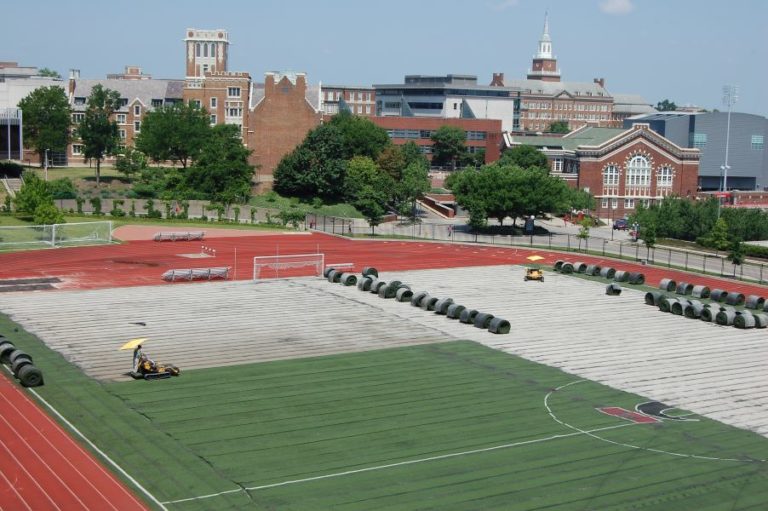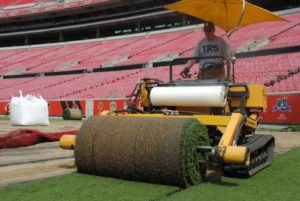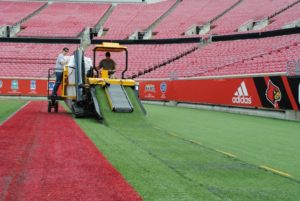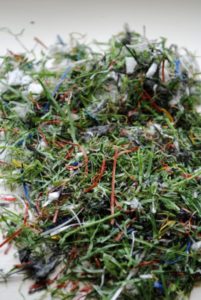By Mary Helen Sprecher
Synthetic fields reach a point (generally 8 to 12 years after installation) where replacement becomes necessary. Torn inseams, reduction of infill, fiber degradation or worn turf – and/or high GMAX ratings – can all be signs that the field has reached the end of its useful life. The question many field owners and managers automatically ask at this point is whether the turf can be recycled.
The definition of recycling, according to the EPA, is “the process of collecting and processing materials that would otherwise be thrown away as trash and turning them into new products.” Looking through that lens, synthetic fields don’t fit that definition of products that can be recycled – at least not the way plastic bottles or aluminum cans are able to be recycled. A used synthetic field can’t be sent to a recycling plant and turned into a brand-new field. However, it’s fair to say that parts of that field can be repurposed or reused.
In some cases, parts of the synthetic field can find new use as surfacing in batting cages, sideline/track protection, small sports practice areas, landscape/erosion control, bed/trailer liners, etc. Generally, this is possible because smaller portions of the turf will be used; after fields have reached the end of their useful life, it is likely some areas (those that see more concentrated play) may be worn and not appropriate for use as a surfacing.
If you’re curious as to whether a whole field can be used as a new athletic surface in another field, the answer is yes – but with a disclaimer that this generally happens only under special circumstances. One example is if a pro team uses a surface for one season (the way the New Orleans Saints do) and then that field is removed and donated to a local high school.
Most fields, however – and the ones we’re focusing on here – have reached the end of their useful life, are showing extensive wear and their surface is not in the same condition as one that has been used only for a few months by a professional team. It is possible to donate these surfaces (schools in impoverished areas outside the USA have been known to accept them; however, transporting the field involves a significant cost that may have to be incurred by the original field owner).
Other options exist for those who want to avoid sending the entire field to a landfill. When a synthetic field is being removed and replaced, it also may be possible to reuse the infill. Reusing the current infill in a new surface lends itself to a cost savings in construction. Specialty equipment is available to remove the infill from the turf – either on site or at a remote location. (Extracting the infill allows it to be reused and dramatically decreases transportation and disposal costs for the turf, since 75 percent or more of the field’s weight is in the infill).
“Any infill you can reclaim is something you don’t have to buy,” said Mark Heinlein of Turf Reclamation Solutions. “Often, the contractor will give the owner some credit for this; they might say, ‘If you want to re-use the infill, we’ll knock this much off our bid.’ That way, both the owner and a contractor get a benefit.”
Advances in technology now allow a synthetic turf field to be taken away for processing and turned into a shockpad that can be used under another field (According to Heinlein, Shaw Sports Turf has pioneered this technology in the United States).
In addition, cleaning and converting old turf into a marketable mixed polymer plastic is possible. Making the conversion economically viable requires identifying and developing downstream markets for the re-compounded polymer pellets. Potential uses might include injection and roto-molded parts and plasticized lumber.
Heinlein notes Europe is currently far ahead of the U.S. market in its ability to recycle synthetic fields. A Danish company, Re-Match, is engaged in the process of separating the components of the field (the carpet, fibers and infill) and creating new products that can be used in the construction of new sports fields. The most challenging aspect of the process, according to the company, has been recycling the fibers; up until now, recycled fibers have not been as strong as the original material. Re-Match has developed recycled fibers it believes are equal to those found on new installations and is currently testing the new turf on several pilot fields.
“That technology absolutely is coming,” said Heinlein. “But it’s not here in the U.S. yet.”
The first step in repurposing and reclaiming field components is separating the turf and infill. Cleaning the turf may increase the potential for its reuse.
The question of what the best and highest uses are for a used synthetic field (and its components) ultimately falls to the owner to decide, given his or her specific circumstances.
Mary Helen Sprecher wrote this article on behalf of the American Sports Builders Association (www.sportsbuilders.org), the national organization for builders, design professionals and suppliers of materials for sports fields, running tracks, tennis courts and indoor and outdoor courts and recreational facilities.





